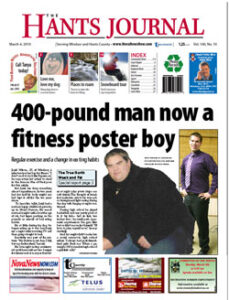Part of a feature on Canadian fitness which included a self-test guide
400-pound man now a fitness poster boy
by Stu Ducklow
Editor, the Hants Journal

Jarid Wilson, 27, of Windsor, is reluctant poster boy for fitness. “I don’t want to look like Superman,” he says, when he’s asked to stand in the famous Man of Steel pose for this article.
But Jarid has done something almost superhuman. In two years he’s lost half his body weight and he’s kept it off for the two years since.
To hear him tell it, Jarid had a normal happy childhood growing up in Mount Denson. He was of normal weight until about the age of six, but began packing on the pounds as a result of bad eating habits.
He at little during the day, but began eating up to two hamburgers a night while watching TV and then going straight to bed. Inactivity was part of the picture. “My dad ate more than I did, but my dad worked,” he said.
His late-night eating accelerated until he would eat two burgers for dinner and as many as four later at night plus potato chips and soft drinks. The thought of breakfast made him sick to his stomach, so his regime of light eating during the day with binging at night continued.
During high school he played basketball and was pretty good at it. A big kid— he’s six feet, two inches now– he could push opponents anywhere on the gym floor but couldn’t move fast himself. “I’d love to play myself now,” he says wistfully.
And his weight didn’t make him a social outcast in high school either. “I always had good friends. And girls liked me. When a guy weighs 350 pounds in high school a girl feels safe.”
But none of his girl friends ever got serious about him, he said. “I was always a teddy-bear boyfriend” but never a serious boyfriend.
His weight increased in university. “You know how kids gain the freshman five pounds, well I gained the freshman 50 pounds.”
At age 22 he weighed 411 pounds and was beginning to have heart palpitations just sitting in a chair. He’d find excuses for not joining his friends at games of golf or basketball.
And when friends confronted him about his weight he just ignored them. “I was in denial. I was young and lazy.”
But finally his mother got to him. She offered to pay his tuition with Alan Mumford Boot Camps if he’d make a serious attempt to lose weight. He agreed.
Mumford pushed him hard with daily exercises, “but the biggest thing I changed was my eating habits.” Now he eats five times a day and goes to bed hungry.
Mumford closed his shop for renovations a month after Jarid began working with him, so Jarid continued on his own. “I just ran with it.” Though Mumford taught him the exercises and basic nutrition, Jarid kept learning on his own.
His father was dying of cancer and the heavy exercise regime helped him deal with his pain.
It wasn’t until he visited the hospital that he found out how much weight he had lost. Up to then, he had been too heavy to use a normal bathroom scale. He was shocked to discover he’d lost 60 pounds in only three months.
His proudest moment came when his father saw him at his target weight, a trim 200 pounds. His waist had shrunk from 52 to 32 inches. “My dad got to see me the way I am now. He was so proud of me, and I was so proud. He felt like I was able to take care of my family.”
But Jarid’s problems weren’t over. He had lost weight so fast that he had extra folds of skin over his chest, stomach and inner thighs. The skin wouldn’t just shrink away on it’s own and MSI, the provincial government health insurance program, refused to cover the cost of plastic surgery because it hadn’t authorized his weight-loss regime.
Jarid borrowed $13,000 and had a private Halifax clinic remove the skin on his stomach and chest.
Today, Jarid has no trouble keeping the weight off. He exercises four times a week and eats healthy food five times a day. Though he’ll eat junk food on weekends — “you still gotta live!” — he feels better when he eats properly.
He has allowed his weight to creep up to 211 pounds but has had no trouble holding his weight and no trouble sticking to his regime, “I live a comfortable lifestyle and I’m a comfortable size.”


